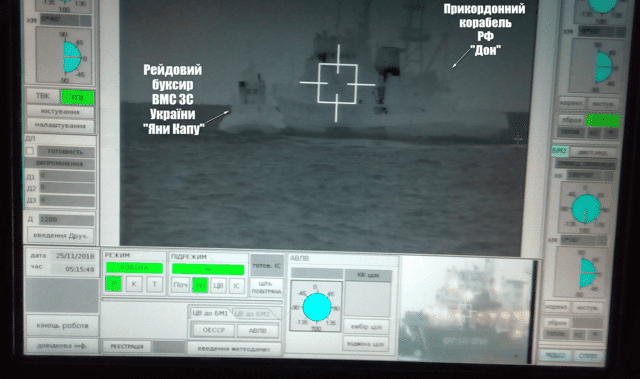What can the Kerch Strait incident teach about nuclear declaratory policy?
By Robert J. Goldston | December 20, 2018
 Ukrainian 'Yani Kapu' tugboat attacked by Russian "Don" patrol boat as seen on a screen of Ukrainian Gyurza-M artillery boat in November 2018 conflict at the Kerch Strait.
Ukrainian 'Yani Kapu' tugboat attacked by Russian "Don" patrol boat as seen on a screen of Ukrainian Gyurza-M artillery boat in November 2018 conflict at the Kerch Strait.
Recent events in the Kerch Strait remind us that Russia has a geostrategic interest in retaking control over its “near abroad” and re-awaken questions about what role nuclear weapons should play in the defense of the allies and partners of the United States.
Let us suppose that Russia attempts to take over all of Ukraine or the NATO-allied Baltic states. Or even Poland. Despite Trump’s tweets, NATO would be obligated by treaty to defend its member states against attack. NATO forces would be marshaled to counter Russian forces. Presumably Russia would stand up rump states that would formally invite in Russian forces.
Now we would have Russian and NATO forces facing each other across some demarcation line. One side might eventually launch an attack to fully evict the other. This would presumably start as a conventional war with tanks, conventional artillery, missiles and aircraft. Some of the missiles and aircraft would likely emanate from Russian and NATO bases, which themselves would naturally become targets for conventional attack.
Suppose that the Russians, by dint of their much shorter supply chain, were able to push back NATO troops. Would NATO initiate the use of tactical nuclear weapons? In the opposite case, in which superior NATO technology helps to push back Russian troops, would Russia resort to tactical nuclear weapons? It seems likely, under current policy, that if one side used tactical nuclear weapons on the battlefield, the other would retaliate in kind. Then each would likely attack the other’s nearby bases with nuclear weapons. Of course, these bases are populated by, and surrounded by, human beings who would be incinerated, and fallout would begin to spread. There would be intense pressure on the leadership of both sides to launch a decapitating nuclear strike against the “criminals who had perpetrated this horror.”
Once the first tactical nuclear weapon is used in Ukraine or the Baltics, under current nuclear policies such a battle would have a high probability of ending in Armageddon. The same story would apply to Taiwan, South Korea, and Japan, with perhaps a moderately reduced version of Armageddon, but unacceptable horror nonetheless. And of course it is this story, and its frightening conclusion, that prevents conventional wars from growing past some limit, as we hope will pertain in Ukraine today.
Nuclear-armed states need to adopt a uniform declaratory nuclear policy that is stabilizing in these cases, strongly reducing the circumstances under which nuclear weapons would be used initially, and also strongly delimiting the cases where they would even be used to retaliate against nuclear attack. It should also de-motivate the preparations for nuclear warfighting that make such a war more likely. A well-verified universal ban on nuclear weapons, as called for in the Treaty on the Prohibition of Nuclear Weapons, would surely be the most stabilizing, but the prospect for nuclear-armed states to sign and ratify this treaty seems to be long-term. Second best would be a “no first use” of nuclear weapons declaratory policy, including, in addition, limitations on nuclear retaliation to nuclear attack. However, such a policy faces resistance from our allies and partners, something that President Obama experienced in the waning months of his administration. It might even motivate more of our allies and partners to construct their own nuclear armaments, leading to additional risks of nuclear confrontation. (Remember that the UK and France have already gone down this path.) On the other hand, the absence of a clear, stabilizing nuclear declaratory policy by the existing nuclear-armed states raises risks of nuclear conflict between them, and increases the motivation for non-nuclear-armed states to develop nuclear weapons, making the situation even worse.
The 2010 Obama Nuclear Posture Review (NPR) declared that, “The United States would only consider the use of nuclear weapons in extreme circumstances to defend the vital interests of the United States or its allies and partners.” The 2018 Trump NPR indicated that these extreme circumstances could “include, but are not limited to, attacks on U.S., allied or partner civilian population or infrastructure, and attacks on U.S. or allied nuclear forces, their command and control, or warning and attack assessment capabilities.” This is clearly meant to include non-nuclear attacks. Such a declaratory nuclear policy does not reduce the risk of nuclear war.
It appears that at this point in history an effective, if imperfect, nuclear declaratory policy for all nuclear-armed states could be: “The sole purpose of our nuclear forces is to defend our states, and our allies and partners, against imminent existential threat from nuclear-armed adversaries, and then only once all other means, diplomatic and conventional military, have been exhausted.” Given the potential consequences of nuclear use, no US ally or partner can expect the US to risk the use of nuclear weapons in a situation short of existential threat to them. The policy proposed here, therefore, should provide them as much reassurance as the present one, and perhaps even more, in that it defines the case where nuclear weapons would be used in their defense, not just considered.
Note an important consequence of this policy: The United States would not use its nuclear forces in response to a non-existential (e.g., limited tactical) nuclear attack, nor would it use nuclear weapons when others means are available. As Middlebury Institute of International Studies scholar Jeffrey Lewis has said, the only way to win the game of nuclear escalation is not to play. Furthermore, if adopted by all of the nuclear-armed states, this policy would provide assurance to non-nuclear-armed states that nuclear weapons would never be used against them, reducing their incentive to acquire such weapons.
This policy (and in general the risks entailed by nuclear use) clearly imply that the United States should try to assure to the degree possible that its conventional forces, in concert with those of its allies and partners, are demonstrably strong enough to repel any conventional attack. Success in this endeavor could provide sufficient assurance to our allies and partners that we could then move to the more desirable “no first use” posture, including the limitations on nuclear retaliation to nuclear attack of the “sole purpose” policy proposed here.
The proposed nuclear declaratory policy does leaves open the possibility of a preemptive (but not preventive) nuclear attack, or an attack on warning. Thus it surely needs to be complemented by a universal policy of non-reliance on “use-it-or-lose-it” nuclear assets. Speaking frankly, a “no first use” policy would not be effective at preventing a nuclear-armed country from attempting to degrade the nuclear assets of its adversary, if it felt that it were under imminent risk of attack and the adversary’s nuclear assets were vulnerable.
So it should be the US position that, failing an ability to reach consensus with our allies and partners on a “no first use” policy, the United States and all other nuclear-armed states should adopt both a “sole purpose” declaratory policy, as described here, and a policy of non-reliance on vulnerable nuclear assets that require hair-trigger launch rules. Indeed the United States, after consulting with its allies and partners, can take this stance unilaterally with no loss of security for any party. Furthermore, this policy needs to be complemented by a strong program of offensive and defensive arms reduction, maintaining nuclear and conventional stability at each stage. This could lead the world down from “mutually assured destruction” to “minimum credible deterrence,” and ultimately to the abolition of all nuclear weapons.
Acknowledgements: The author would like to thank his colleagues Bruce Blair and Hal Feiveson for their insightful comments.
Together, we make the world safer.
The Bulletin elevates expert voices above the noise. But as an independent nonprofit organization, our operations depend on the support of readers like you. Help us continue to deliver quality journalism that holds leaders accountable. Your support of our work at any level is important. In return, we promise our coverage will be understandable, influential, vigilant, solution-oriented, and fair-minded. Together we can make a difference.
Topics: Analysis, Nuclear Risk, Nuclear Weapons















Some of Russia’s new generation systems are superior to those of Nato and in some cases have no western analogues. Russia has all of European Nato outgunned for sure. But the real question is how willing certain leaders are to use nukes, and if they do, how far would it go?
A nuclear deterrent is plainly risky, illogical, unwise and manifestly counter productive. It only forces other powers that can afford to do so to match our forces, and it incites non state actors to respond in whatever way they can, including acquiring weapons themselves. The author apparently believes [especially unilateral] disarmament is not an option, and thus is left with advocating clarifying statements on the margins which do not significantly reduce the risks on paper and in practice are unenforceable. I believe the only way to actually limit the risks is to unilaterally abolish all of our nuclear forces. See… Read more »